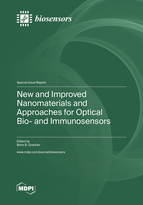New and Improved Nanomaterials and Approaches for Optical Bio- and Immunosensors
A special issue of Biosensors (ISSN 2079-6374). This special issue belongs to the section "Biosensors and Healthcare".
Deadline for manuscript submissions: closed (30 November 2022) | Viewed by 25717
Special Issue Editor
Interests: immunochemistry; immunoassays; bio- and immunosensors; engineering nanoparticles; nanosafety
Special Issues, Collections and Topics in MDPI journals
Special Issue Information
Dear Colleagues,
The current priorities for development in the field of bio- and immunosensors are highly sensitive detection and increased information output. An important resource for achieving these goals is provided by new nanomaterials and their functionalized derivatives. The use of such carriers and labels combined with optical registration has good prospects for advancement into practice due to the availability of simple inexpensive detectors and the possibility of non-instrumental (visual) assessment of the analysis results. Approaches to highly sensitive assays based on the use of fluorescent nanoparticles, the transformation of chromogenic substrates by nanozymes, the aggregation of modified nanoparticles, or, conversely, the release of multiple labels from nanocontainers are extremely successful. The use of various receptors (antibodies, aptamers, etc.) and additional functional molecules provides approaches to modulate selectivity, productivity, detection limits, and other important parameters of novel biosensors. However, many possibilities of using nanomaterials in biosensors remain uncharacterized. There is a lack of compelling comparisons to select the best preparations and assay techniques.
This Special Issue is aimed at considering new approaches to highly sensitive bio- and immunosensoric analysis using nanodispersed labels and their optical registration. We are interested in both descriptions of original ideas and comparisons of different approaches. We are welcoming papers describing the development of such sensors and their application in various practically demanded areas—medical diagnostics, biosafety, quality control of foods and other consumer products, and environmental monitoring.
Prof. Dr. Boris B. Dzantiev
Guest Editor
Manuscript Submission Information
Manuscripts should be submitted online at www.mdpi.com by registering and logging in to this website. Once you are registered, click here to go to the submission form. Manuscripts can be submitted until the deadline. All submissions that pass pre-check are peer-reviewed. Accepted papers will be published continuously in the journal (as soon as accepted) and will be listed together on the special issue website. Research articles, review articles as well as short communications are invited. For planned papers, a title and short abstract (about 100 words) can be sent to the Editorial Office for announcement on this website.
Submitted manuscripts should not have been published previously, nor be under consideration for publication elsewhere (except conference proceedings papers). All manuscripts are thoroughly refereed through a single-blind peer-review process. A guide for authors and other relevant information for submission of manuscripts is available on the Instructions for Authors page. Biosensors is an international peer-reviewed open access monthly journal published by MDPI.
Please visit the Instructions for Authors page before submitting a manuscript. The Article Processing Charge (APC) for publication in this open access journal is 2700 CHF (Swiss Francs). Submitted papers should be well formatted and use good English. Authors may use MDPI's English editing service prior to publication or during author revisions.
Keywords
- biosensors
- immunosensors
- rapid tests
- nanosized labels
- functionalized nanoparticles
- high-sensitive detection
- signal amplification
- cascade enhancement of signal
- aggregates of nanoparticles
- nanozymes
- fluorescent nanoparticles
- switchable optical sensors
- energy transfer in biosensors







